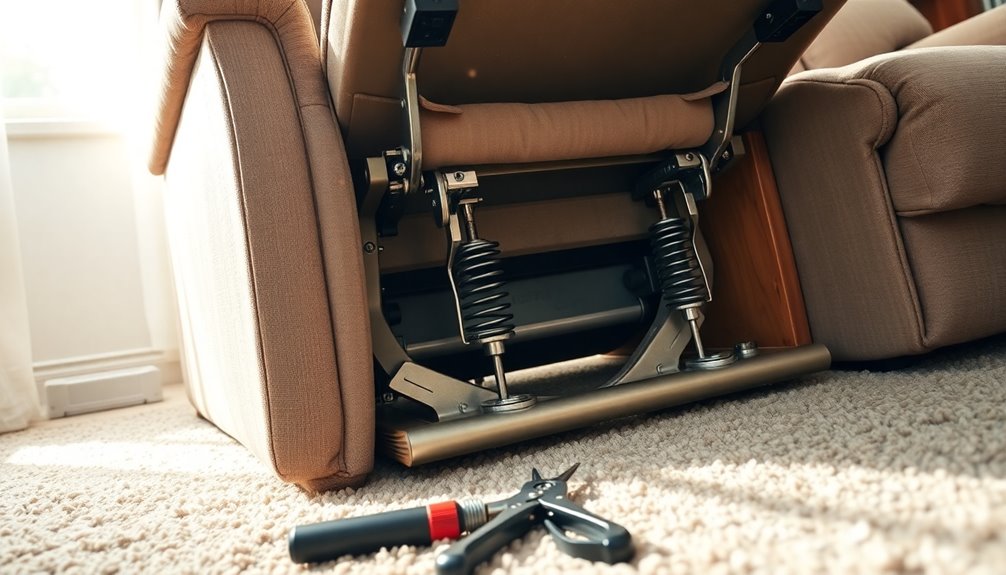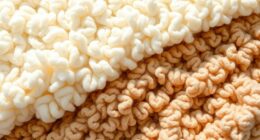Taking apart a recliner sofa isn't too tricky if you follow some steps. Start by removing any cushions and checking for screws or bolts that secure the frame. Make sure to tighten any loose connections before disassembly for stability. Next, gently separate the reclining mechanism from the frame; it usually slides out. If your sofa has armrests, they may need unscrewing as well. Keep track of all parts and bolts for reassembly. Finally, take care not to damage the upholstery or frame during the process. Want tips on maintaining your sofa's condition after disassembly? You'll find plenty of helpful advice.
Key Takeaways
- Review the warranty terms to avoid voiding coverage during disassembly.
- Document the disassembly process to support future warranty claims.
- Remove cushions and any detachable components before proceeding.
- Unscrew and detach the reclining mechanism from the frame carefully.
- Minimize friction on joints to maintain structural integrity during disassembly.
Introduction
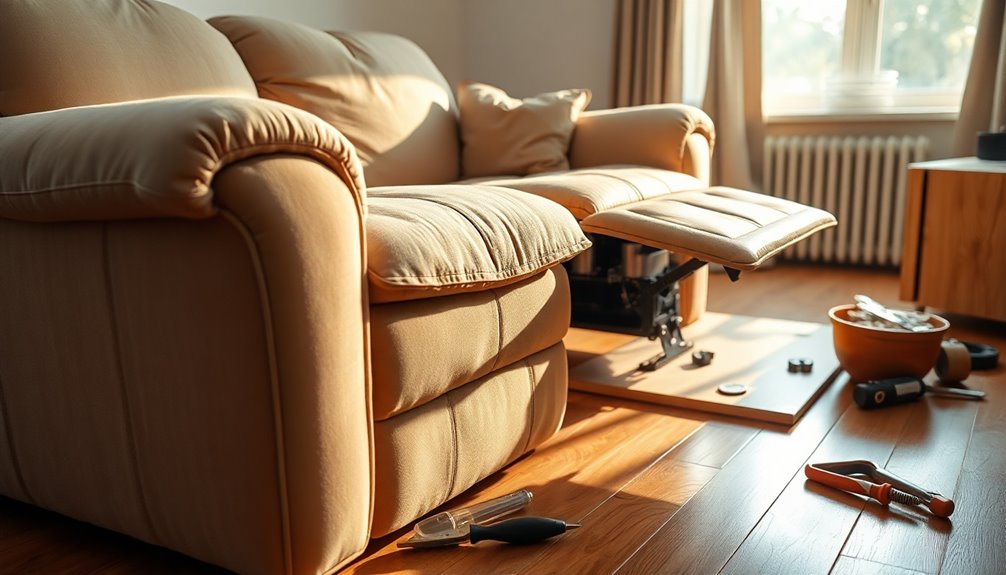
When you take apart your recliner sofa, it's a great opportunity to give the upholstery some care. You'll want to use fabric-specific cleaning techniques to tackle any stains, especially if you've dealt with wine spills or pet accidents. Keeping your sofa in top shape will make the reassembly process even more rewarding.
Routine Upholstery Care Tips
Your recliner sofa is a centerpiece in your living space, so keeping it looking great requires regular care. To start, make sure you regularly vacuum your sofa using an upholstery attachment. This will help you remove dust, dirt, and debris that can accumulate in the fabric and seams. If you encounter any stains, promptly blot the area with a clean, damp cloth and use a mild fabric cleaner to avoid setting the stain or damaging the upholstery.
Additionally, it's a good idea to rotate and fluff the cushions periodically. This practice helps maintain their shape and prevents uneven wear over time. You should also be mindful of where you place your recliner. Keeping it away from direct sunlight is crucial, as this prevents fading and damage to the upholstery material.
Finally, don't forget to check and tighten any loose screws or mechanisms regularly. This ensures the recliner functions properly and maintains its structural integrity. By following these routine upholstery care tips, you can prolong the life of your recliner sofa and keep it looking as good as new for years to come.
Fabric-Specific Cleaning Techniques
Understanding the specific cleaning techniques for different fabric types is essential for maintaining your recliner sofa's appearance and longevity. Fabrics like microfiber, leather, and cotton each require unique care. For example, you can clean microfiber with a damp cloth, but leather needs special leather cleaner to prevent damage. Always check the manufacturer's cleaning code on your sofa's tag to know the appropriate methods and products.
When it comes to stains, act quickly. Use a blotting technique rather than rubbing, as rubbing can cause the stain to spread or embed deeper into the fabric. Regular vacuuming is crucial; it helps maintain fabric integrity and prevents dirt buildup. Make it a habit to vacuum your sofa to keep it looking fresh and clean.
If you need to use a cleaning solution, always test it on a hidden area of the fabric first. This ensures there's no adverse reaction or discoloration before applying it to the visible areas. By following these fabric-specific cleaning techniques, you'll keep your recliner sofa in top shape for years to come.
Tackling Wine and Pet Urine
Dealing with wine and pet urine stains can be daunting, but quick action makes all the difference. When you spot a wine stain on your upholstery, act quickly by blotting the area with a clean cloth. This helps absorb excess liquid before you apply a cleaning solution—a mixture of water and dish soap works effectively to lift the stain away. Remember, avoid rubbing the fabric; it can spread the stain and damage the fibers. Instead, gently dab the area.
For pet urine odors, an enzymatic cleaner specifically designed to break down urine components is your best bet. It not only tackles the stains but also neutralizes lingering smells. Just like with wine, always test your cleaning solution on a hidden area of the fabric first to ensure it won't cause discoloration or further damage.
Regular maintenance is key, too. Vacuuming your upholstery and using fabric protectants can help prevent stains from setting in, making future clean-ups much easier. By following these steps, you'll keep your recliner sofa looking fresh and clean!
Avoiding Direct Sunlight
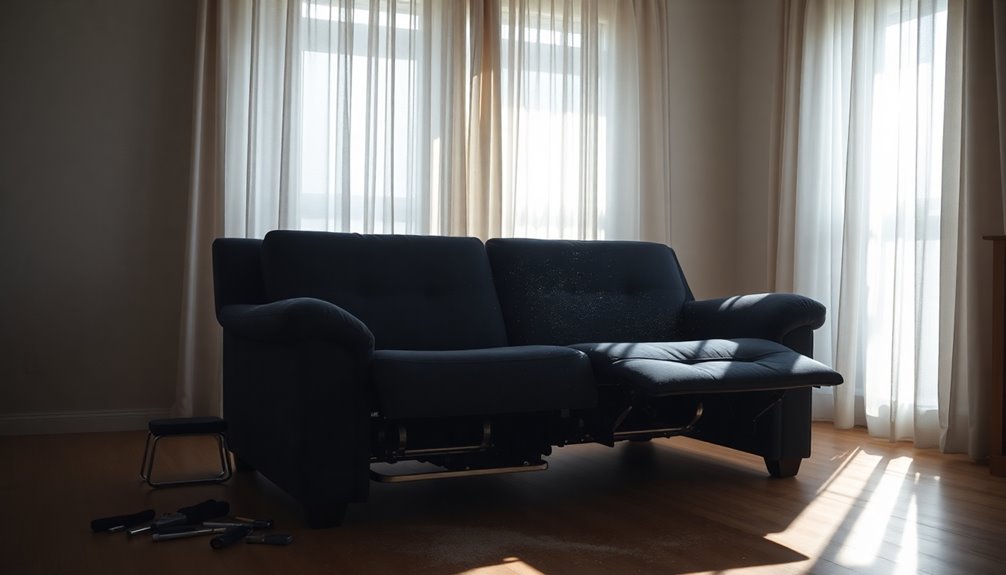
When you take apart your recliner sofa, keeping it out of direct sunlight is crucial for protecting its materials. Consider using water-resistant fabric options or stylish throws to shield the upholstery from UV rays, which can weaken and fade it. Additionally, minimizing friction on joints during disassembly can help maintain the sofa's integrity while avoiding sun exposure.
Water-Resistant Fabric Options
Choosing water-resistant fabric options for your recliner sofa can enhance both comfort and durability, especially if you take care to avoid direct sunlight. Fabrics like treated polyester, vinyl, and acrylic are designed to repel moisture and prevent stains, making them ideal for homes with kids or pets. By selecting a water-resistant fabric, you significantly reduce maintenance costs since these materials are easier to clean and less prone to damage from spills.
However, it's crucial to keep your water-resistant recliner out of direct sunlight. Prolonged exposure to UV rays can degrade the fabric over time, leading to fading and a loss of those valuable water-resistant properties. Many manufacturers now offer breathable options, ensuring you enjoy comfort while maintaining protection against moisture.
To keep your recliner in top shape, regular cleaning is essential. Apply protective sprays periodically to maintain the water-resistant qualities, which can extend the lifespan of your sofa. By taking these steps, you can enjoy a stylish and functional recliner sofa that withstands the test of time and wear.
Protect With Stylish Throws
Your recliner sofa deserves protection from the damaging effects of direct sunlight, and stylish throws can provide just that. By draping your sofa with UV-protective throws, you not only shield it from harmful rays that cause fabric fading and deterioration, but you also elevate its aesthetic appeal. Opt for durable, fade-resistant materials to ensure your throws maintain their color and quality, even with prolonged exposure to sunlight.
To keep your stylish throws looking fresh, make it a habit to rotate and wash them regularly. This practice will help prevent any sunlight-related wear from becoming evident. Additionally, consider layering throws with varying textures or patterns; this not only adds a fashionable touch but also enhances the overall decor of your home.
Incorporating these protective measures will give your recliner sofa an extra layer of defense while allowing you to express your personal style. So, don't overlook the importance of stylish throws; they're a simple yet effective way to protect your investment and keep your living space looking great.
Minimize Friction on Joints
How can you ensure the longevity of your recliner sofa's joints during disassembly? First, pay attention to the environment where you're working. Avoid exposing the joints to direct sunlight, as prolonged heat can warp or weaken materials over time. Keeping your disassembled parts in a cool, dry place is essential for preserving their integrity.
Next, use a silicone-based lubricant to minimize friction on the joints. This step is crucial for ensuring smooth movement as you take apart and later reassemble your sofa. Regularly inspect the joints for any signs of wear or damage caused by friction, since neglecting this can lead to premature failure of the reclining mechanism.
Additionally, consider using felt pads or furniture sliders on the joints. These tools further reduce friction and protect the sofa's components during handling. By taking these precautions, you'll not only make the disassembly process easier but also extend the life of your recliner sofa. Prioritizing these steps helps maintain the quality of your furniture, ensuring it remains functional and beautiful for years to come.
Regular Joint Lubrication
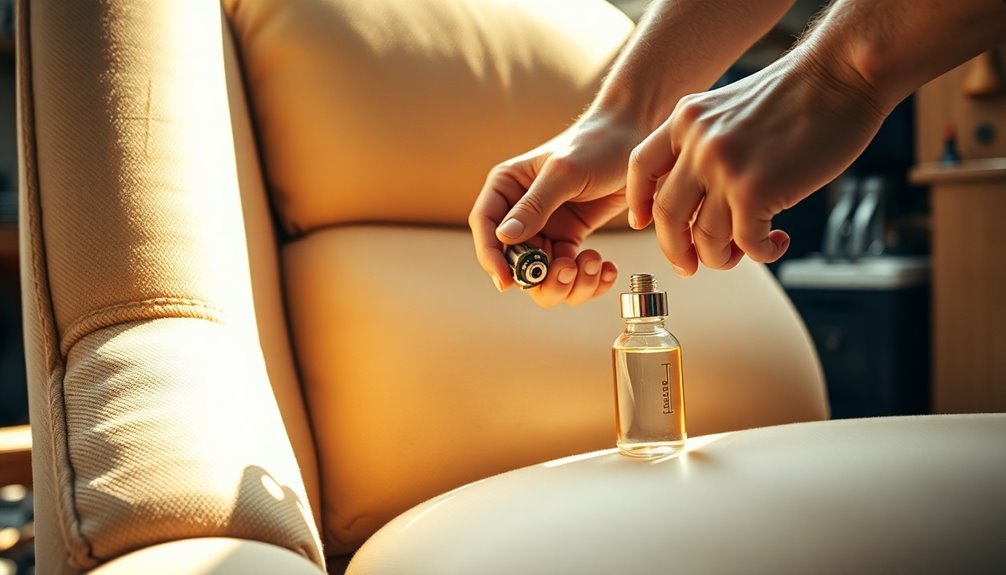
Regular joint lubrication isn't just about keeping your recliner sofa quiet; it also helps prevent joint alignment problems and can even revive worn leather surfaces. By ensuring smooth movement, you can avoid stressing the couch's structure, which might lead to more significant issues down the line. Plus, with properly maintained joints, you'll make it easier to access and replace cushion foam when needed.
Joint Alignment Problems
Maintaining the joints of your recliner sofa is crucial for ensuring smooth operation and preventing alignment problems. Regular lubrication of these joints stops stiffness from creeping in, which can lead to misalignment over time. When you use a silicone-based lubricant or a similar product designed for furniture, you help reduce friction and wear on the moving parts, promoting longevity.
It's a good idea to inspect and lubricate the joints every six months. Pay special attention to pivot points and areas where metal meets metal, as these spots are most vulnerable to wear and misalignment. If your recliner starts making excessive noise or you notice difficulty in the reclining mechanisms, it's a clear sign that the joints need immediate lubrication or adjustment.
Ignoring these issues can lead to significant damage down the line. By staying proactive with maintenance, you can ensure optimal performance and extend the lifespan of your recliner sofa. Remember, a little lubrication goes a long way in maintaining proper joint alignment and keeping your recliner functioning smoothly.
Reviving Worn Leather Surfaces
Reviving worn leather surfaces on your recliner sofa can breathe new life into its appearance and comfort. One key aspect of this process is regular lubrication of the joints. By using a silicone-based lubricant or a leather conditioner that includes conditioning agents, you can nourish the leather while protecting the moving parts. This maintenance helps prevent friction and wear, ensuring smooth operation and extending the life of your recliner.
When applying lubrication, do it sparingly to avoid excess buildup, which can attract dust and debris. Focus on key joint areas, particularly where the recliner mechanism connects to the frame. This targeted approach not only promotes optimal movement but also prevents annoying creaking or sticking.
It's advisable to perform this maintenance every six months. Consistent lubrication keeps your recliner in good working order, enhancing your overall comfort. By taking the time to care for both the leather and the joints, you'll ensure that your recliner sofa looks great and functions smoothly for years to come. So, grab your leather conditioner or lubricant, and give your recliner the attention it deserves!
Cushion Foam Replacement
To keep your recliner sofa comfortable and supportive, it's essential to inspect the cushion foam periodically for wear and tear. If you notice any damage, you should replace the foam to maintain the sofa's usability. Opt for high-density foam, ideally at least 1.8 pounds per cubic foot, to ensure long-lasting comfort.
When replacing the cushion foam, consider adding a layer of memory foam on top for enhanced comfort and pressure relief. This combination not only improves the overall feel but also prolongs the life of your sofa.
Additionally, don't forget about the joints and reclining mechanisms. Lubricate them with a silicone-based spray or lithium grease every six months to prevent squeaking and ensure smooth operation. Regular lubrication is vital for the overall function of your recliner, and it keeps everything in good shape.
Always follow the manufacturer's guidelines for both cushion foam replacement and lubrication. This helps you avoid voiding warranties or compromising the integrity of your sofa. By staying proactive about these maintenance tasks, you'll keep your recliner sofa feeling like new for years to come.
Reinforcing Frame Stability
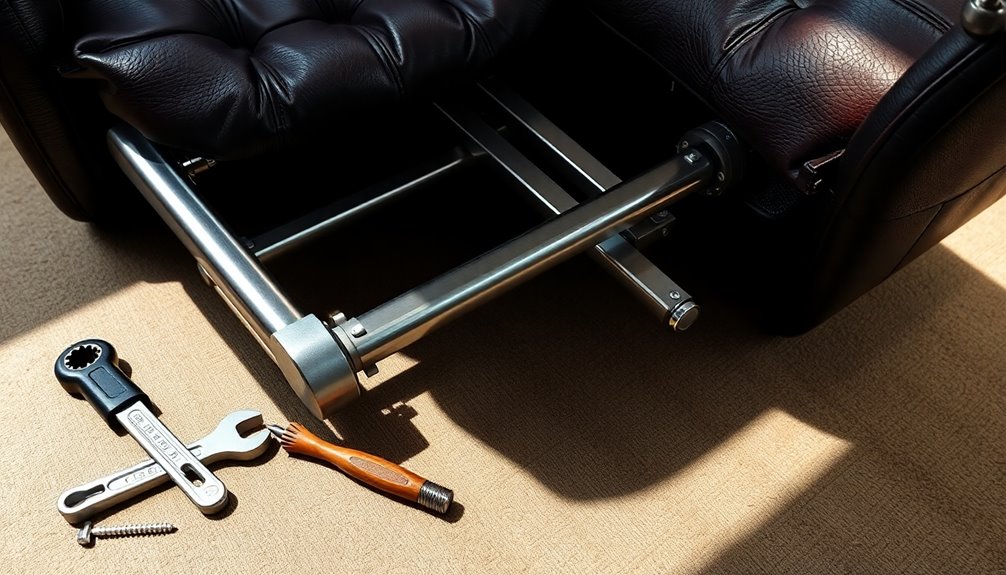
When disassembling a recliner sofa, reinforcing frame stability is crucial to ensure a solid structure during and after the process. Start by tightening all screws and bolts connecting the frame components. This step prevents wobbling or damage while you work. As you take apart the sofa, keep an eye out for any loose joints. If you find any, use wood glue or corner braces to enhance the overall structural integrity of the frame.
If your recliner has a reclining mechanism, inspect it for wear or looseness that could compromise stability. Repair or replace any worn parts as needed. Additionally, consider adding reinforcing plates or support brackets in high-stress areas to prevent future instability after reassembly.
Once you've disassembled the sofa, store the frame components carefully. Avoid placing any pressure or weight on the joints, as this can compromise their structural integrity. By taking these precautions, you'll ensure that the recliner sofa remains sturdy and reliable once you put it back together, allowing you to enjoy it for years to come.
Extended Warranty Considerations
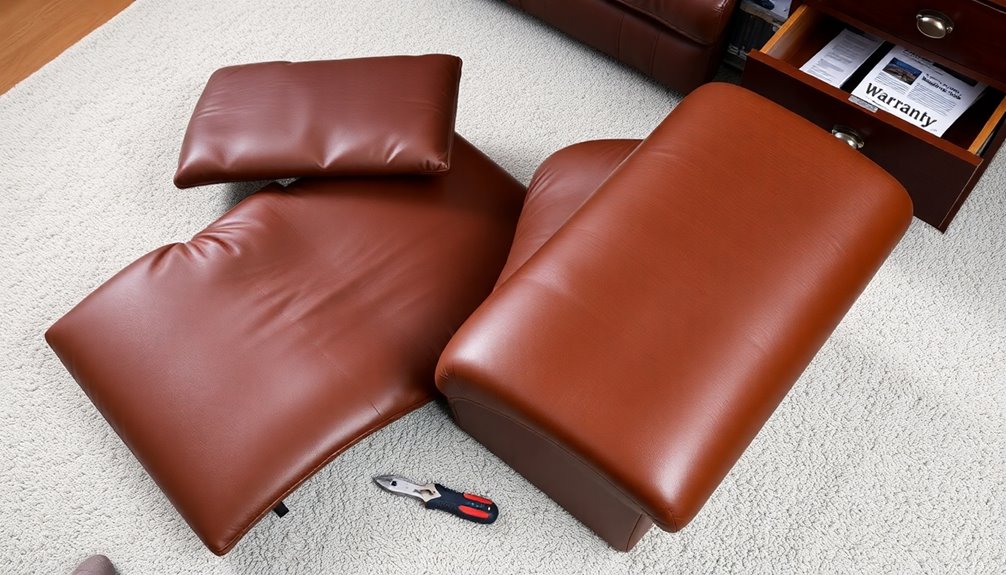
Before you start disassembling your recliner sofa, it's essential to understand how your extended warranty might be affected. Extended warranties typically cover defects in materials and workmanship, but they often exclude damage caused by improper disassembly or moving. To avoid losing coverage, review the warranty terms carefully. Some warranties may void protection if you take apart the sofa yourself.
Many extended warranties require you to use authorized service providers for repairs. If you attempt the disassembly process without professional guidance, you could jeopardize any future warranty claims. It's crucial to keep this in mind to ensure you don't accidentally breach the terms of your warranty.
Additionally, if you do need to make a claim, be prepared to provide proof of purchase and possibly documentation of how you disassembled the sofa. This can help confirm you adhered to any warranty guidelines. Before taking apart your recliner sofa, it's wise to consult your warranty provider. They can clarify any specific instructions or recommendations, helping you avoid unintentional violations of the warranty terms that could lead to costly repairs down the line.
Conclusion
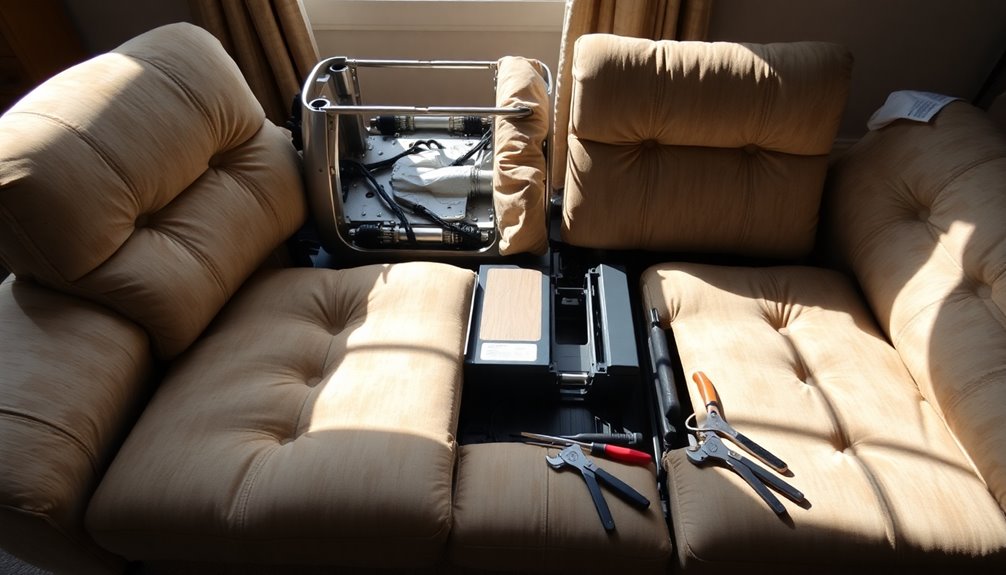
Understanding your warranty is just the first step in successfully taking apart your recliner sofa. It's essential to follow the right steps to ensure you don't damage any components. Start by checking for detachable backs, often secured with Velcro or clips. This can take some patience, but it's crucial for a smooth disassembly. Before you begin, remember to unplug any electrical wires connected to powered reclining mechanisms to avoid damage.
Every time you remove the backs, be prepared for dust and debris to fall out, so having a vacuum handy is a smart idea. Once the backs are off, assess the weight distribution of the remaining parts. This will help you maintain control and prevent injury while moving them.
One thing you should always do is inspect the disassembled parts for any damage before and after the process. This ensures your recliner sofa is still going strong for years to come. By following these steps carefully, you can take apart your recliner sofa efficiently and maintain its integrity, allowing you to enjoy it for many more comfortable moments.
Frequently Asked Questions
How Do You Take Apart a Reclining Sofa for Moving?
To take apart a reclining sofa for moving, start by unplugging any electrical components. Next, locate the detachable backs, removing them carefully, as they might be secured with Velcro or clips. It’s helpful to have a friend assist you in lifting and maneuvering the sofa to maintain balance. Before you start, measure doorways and obstacles to find the best angles for disassembly. Finally, check for any damage once the sofa is apart. Once the sofa is in manageable pieces, focus on how to lift a heavy sofa safely. Bend at the knees and keep your back straight to prevent injury, and ensure that your grip is secure on any parts you are handling. With careful coordination, you and your friend can navigate any tight spaces as you move the pieces to their new location.
Do All Reclining Sofas Come Apart?
Not all reclining sofas come apart. Some models are designed as fixed pieces, meaning they can't be disassembled. However, many traditional sofas have removable backs, which you can detach for easier moving. If you've got a modular design, you'll find sections that can be separated. For electric models, remember to unplug any components first. Always check the manufacturer's guidelines to see if your specific sofa can be taken apart safely.
Can a Recliner Sofa Be Dismantled?
Yes, a recliner sofa can usually be dismantled. You'll often find that the backs are detachable, secured with clips or Velcro. Before you start, make sure to unplug any electrical connections to avoid hazards. As you remove the backs, be prepared for some dust and debris to fall out. Lift each section carefully to maintain balance, and check for any damage before and after disassembly to ensure everything's in good shape.
Can You Take a Recliner Apart to Move It?
Yes, you can take a recliner apart to move it. Many recliners have detachable parts, which makes the process easier. Start by checking for any clips or Velcro that secure the back. Before you begin, unplug any electrical components to avoid hazards. As you dismantle, be ready for dust and debris to fall out. Remember to assess the weight distribution to lift safely and prevent injury or damage during the move.
